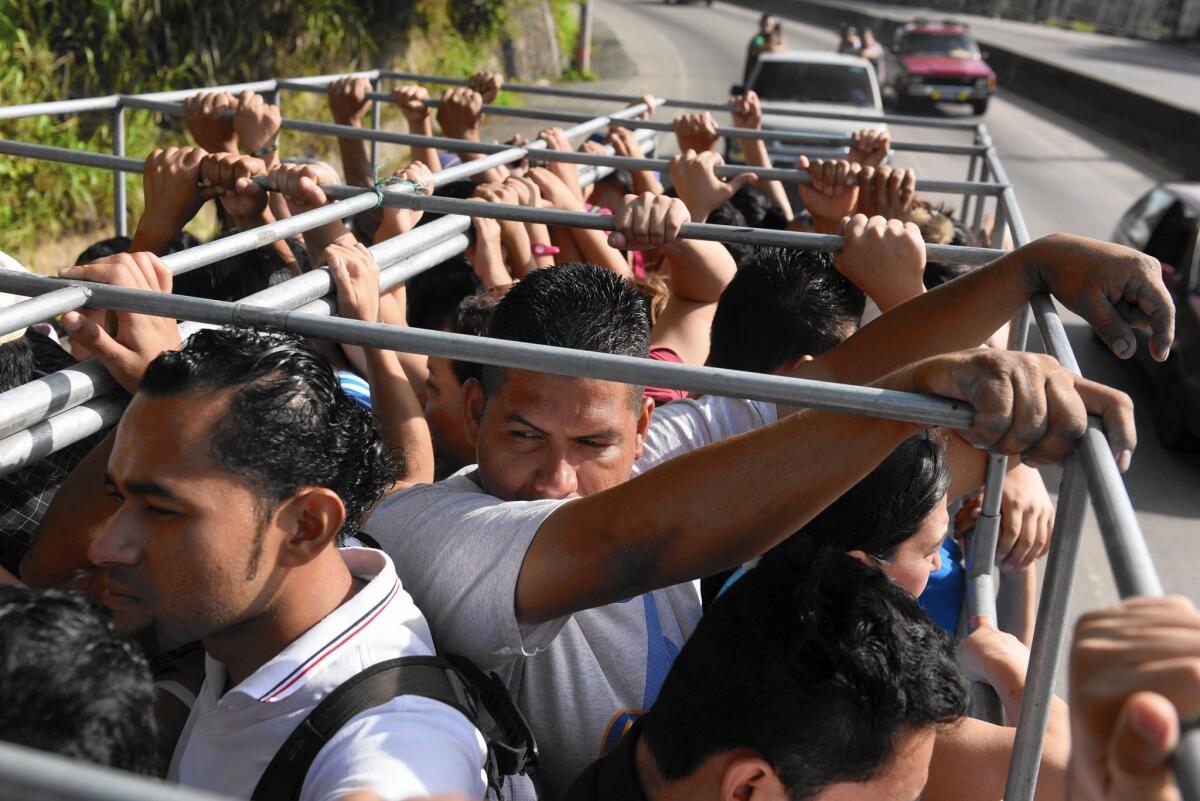Gang killings of bus workers freezes San Salvador’s transportation system

- Share via
Reporting fromMexico City — El Salvador’s street gangs paralyzed the capital city of San Salvador on Wednesday as many bus drivers stayed clear of their routes after the killing of at least nine transportation workers in a challenge to the government’s crackdown on violence.
Police and local media said Wednesday that the chaos was spreading.
“There is a death sentence for our people here who go out to work, for those who don’t want to pay extortion. Here [the authorities] have to be stronger,” Genaro Ramirez, president of the union representing bus companies, said during a news conference in the Salvadoran capital.
In the third day of de facto strikes, at least 142 routes through the teeming capital were shut down and there were no immediate prospects of normal transportation resuming soon, Ramirez said.
NEWSLETTER: Get the day’s top headlines from Times Editor Davan Maharaj >>
“Things are getting worse,” he said, an assessment shared by Salvadoran news media, which reported a nearly 50% increase overnight in idled bus routes. The city of 1.8 million residents lacks a subway, suburban train network or other alternative for shuttling people to their jobs.
Television showed stranded bus passengers piling into pickup trucks provided by the government to try to get them to their jobs and errands. Private truck owners were stepping in to offer rides, but at as much as four times the normal fare charged, the Prensa Grafica news website reported.
Photographer Oscar Machon, who works for newspapers, said in a telephone interview from San Salvador that at least 60% of the city’s bus service had ground to a halt.
“But people are trying to get to work as best they can, walking or taking other options,” he said. “They can’t stop working because of this; they have to get by.”
With thousands unable to make their way across the vast city, normal commerce and services were suffering. Prensa Grafica said nearly 1,500 surgeries and medical procedures had to be canceled because of the transportation snarl.
Random slayings in El Salvador are nothing new, as the country vies with neighboring Honduras for the highest homicide rate in the hemisphere. But attacks on public transportation workers, which began last weekend and grew to nine fatalities by Wednesday, speak to an escalation of the violent showdown between the gangs and Salvadoran authorities trying to rein in their power.
The main criminal rings, the Mara Salvatrucha and the Barrio 18, were born on the streets of Los Angeles, formed by thousands of young people who fled to the United States to escape the violent civil war that began in 1979. When the fratricide abated in the early 1990s, the United States deported thousands of the gangsters, who have since regrouped to fight one another for control of drug markets and territory in their homeland.
Slayings in the country have jumped by more than 50% this year. A government-brokered truce negotiated between the gangs in 2012 broke down in May 2013.
President Salvador Sanchez Ceren, who had moved some gang leaders out of maximum-security prisons to lock-ups closer to their families and extended more privileges to them as part of the cease-fire agreement, recently moved them back and launched the crackdown against the estimated 60,000 gangsters terrorizing the nation of 6 million.
The body count is a result of not just gang-on-gang violence, but a mounting “small scale war” between the government and the gangs, according to Jose Miguel Cruz, research director at Florida International University’s Kimberly Green Latin American and Caribbean Center.
“Part of the gang push is to try to force the government to let up on its crackdown,” Cruz said in a telephone interview from San Salvador.
The targeting of the capital’s public transportation system sends a brazen message that the gangs retain the power to sow disorder and fear.
“The government is outnumbered and the gangs have effective control in some parts of the country and here in the city. The government can’t send enough police in to gain control of communities where the gangs have had control for so long,” said Cruz.
The government crackdown has been harsh and reports have circulated of police massacres of civilians. Still, Sanchez Ceren’s administration has been unable to contain the gangs or shield the public.
The gangs remain a problem for the United States as well. People are fleeing El Salvador to the United States to escape the violence. Last year, there was a surge of unaccompanied minors arriving at the U.S. border from Mexico through which their parents sent them to escape the gang warfare.
“There is a sense among people on the streets here that things are spiraling out of control,” Cruz said.
Special correspondent Bonello reported from Mexico City and Times staff writer Williams reported from Los Angeles.
ALSO:
Search for MH370: Investigators believe debris is from missing Malaysia jet
Killing of Cecil the lion spotlights reports of corruption in southern Africa
Eurotunnel crisis: Crush turns deadly as migrants push toward Britain
More to Read
Sign up for Essential California
The most important California stories and recommendations in your inbox every morning.
You may occasionally receive promotional content from the Los Angeles Times.











